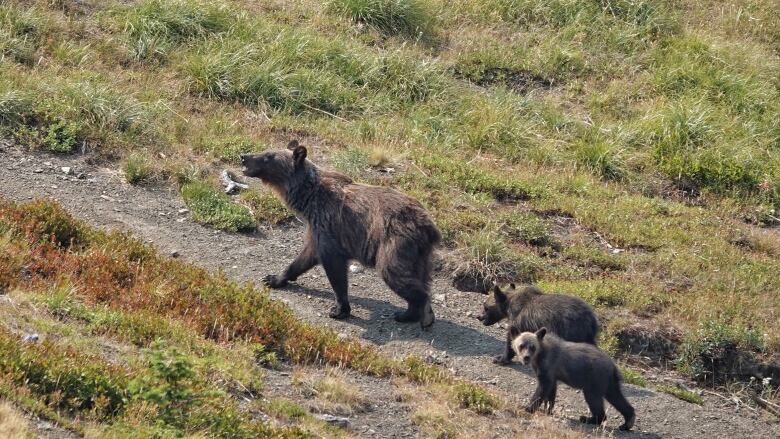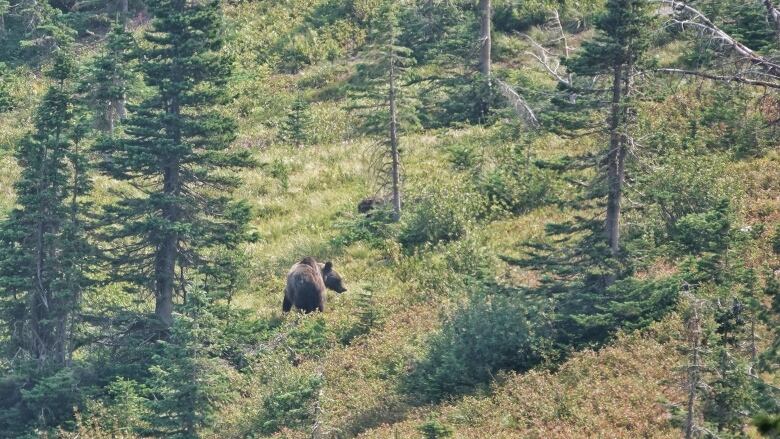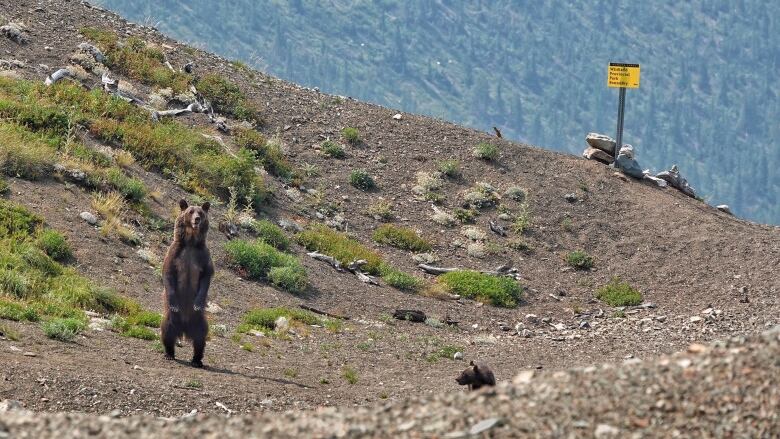Calgary naturalist recounts memorable sighting of grizzly bear family
Brian Keating spotted a grizzly and two cubs from a safe distance on Friday

It's one of the most memorable bear encounters that Brian Keatinghas experienced and the Calgary naturalist is no stranger to bears, having had the privilege of seeing many over the years.
He and his wife came across a grizzly and two cubs whilehiking in Castle Wildland Provincial Park on Friday morning.
"It's left my wife and I with an intensely profound feeling that we have seen such an amazing symbol of our Canadian wilderness out there trying to make a living," Keating told The Homestretch on Tuesday.
Hiking to the Middle Kootenay Pass, they noticed lots of ripe buffalo berries and huckleberries perfect bear food. So they madenoise to make their presence known, just in case.
Sure enough, they spotted a cub on the trail approaching the pass from the other side. Keating and his wife, bear spray at the ready, immediately moved away to an open slope to the right of the pass,givingthe animals lots of space.

Noticingtheir movements, the adult grizzly stood up to get a better view. She decided they weren't a threat and took her cubs up the opposite slope to feed on huckleberries, then go on their way.
Lucky encounter?
There have been three fatalities from bears in Alberta this year, including one this past weekend near Swan Hills.Canmore-based bear biologist Sarah Elmeligi saysthe fatalities are tragic, but veryrare.
"You might have a higher chance of being struck by lightning than being attacked by a bear," she told the Calgary Eyeopener on Tuesday. "The more likely encounter is that you see a bear and a bear sees you and you both go your separate ways and nothing happens."
When bears are surprised, though,their reaction can be less predictable. Especially during berry season in late summer, bears can be so focused on eating as much as possible that they might not hear, see or smell you coming so it's critical to make your presence known.
Make noise, travelin a group, havedogs on a leash and carry bear spray, said Elmeligi.If you see a bear, give it space just as Keating did.
Feeding the family
The female bear was "certainly not plump," said Keating, but withtwo cubs to feed, that's not surprising.

"You have to realize that the largest nutritional cost comes when she first comes out of the den in the spring and there's not a lot to eat," he said. "The cubs need to grow fast. Their metabolic rate is a lot higher now that they're out moving around."
While in the den, a bear cub consumes about 10 per cent of their yearly milk requirement.In the spring, that demand increases about four-fold, leaving mom producing a minimum of a litre of milk per day per cub.
"Her entire life objective right now is to gather enough high energy food to continue to produce that milk and to start putting on the necessary weight that she'll need for her eventual hibernation," said Keating.
As the cubs grow during their first summer, their nutritional needs will outpace the mother's ability to produce milk, so they get introduced to other food sources, like berries.
Efficient berry harvesters
Bears gather berries quickly, swallowing them whole. The seeds passthrough their digestive tract unbroken and able to germinate, making bears important seed dispersers.

According to the Bear Smart Society, grizzlies in Banff National Parkhave been documented to eat more than 200,000 buffalo berries in a single day.
As fall approaches, bears enter a state calledhyperphagia. Hungry all the time, that'swhen they pack on as much fat as possible to see them through a long winter sleep.
They'll eat anything they can get their paws on, including bulbs of plants, ground squirrels, ants and ant eggs hidden in the middle of rotting logs.
"It's a real all-out effort to try to put on that weight," said Keating.
He said that to see a healthy family out in the wild, undisturbed by a couple spectators, was something special.
"The whole event couldn't have played out better," said Keating. "We felt extremely privileged."
For more fascinating stories about Alberta's wildlife from naturalist Brian Keating, visit hiswebsiteand check out these stories:
- Alberta has 7 species of cicada and they're among the loudest insects on the planet
- From finches to robins, it's not uncommon for birds to build their homes on your homes
- Rare black ground squirrel spotted in Banff alpine area
- Porcupine photography requires quiet patience in the woods, naturalist Brian Keating says
With files from The Homestretchand the Calgary Eyeopener.












_(720p).jpg)


 OFFICIAL HD MUSIC VIDEO.jpg)
.jpg)



























































































